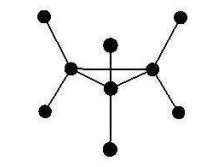6.12: Cyclopropane
- Page ID
- 149475
\( \newcommand{\vecs}[1]{\overset { \scriptstyle \rightharpoonup} {\mathbf{#1}} } \)
\( \newcommand{\vecd}[1]{\overset{-\!-\!\rightharpoonup}{\vphantom{a}\smash {#1}}} \)
\( \newcommand{\id}{\mathrm{id}}\) \( \newcommand{\Span}{\mathrm{span}}\)
( \newcommand{\kernel}{\mathrm{null}\,}\) \( \newcommand{\range}{\mathrm{range}\,}\)
\( \newcommand{\RealPart}{\mathrm{Re}}\) \( \newcommand{\ImaginaryPart}{\mathrm{Im}}\)
\( \newcommand{\Argument}{\mathrm{Arg}}\) \( \newcommand{\norm}[1]{\| #1 \|}\)
\( \newcommand{\inner}[2]{\langle #1, #2 \rangle}\)
\( \newcommand{\Span}{\mathrm{span}}\)
\( \newcommand{\id}{\mathrm{id}}\)
\( \newcommand{\Span}{\mathrm{span}}\)
\( \newcommand{\kernel}{\mathrm{null}\,}\)
\( \newcommand{\range}{\mathrm{range}\,}\)
\( \newcommand{\RealPart}{\mathrm{Re}}\)
\( \newcommand{\ImaginaryPart}{\mathrm{Im}}\)
\( \newcommand{\Argument}{\mathrm{Arg}}\)
\( \newcommand{\norm}[1]{\| #1 \|}\)
\( \newcommand{\inner}[2]{\langle #1, #2 \rangle}\)
\( \newcommand{\Span}{\mathrm{span}}\) \( \newcommand{\AA}{\unicode[.8,0]{x212B}}\)
\( \newcommand{\vectorA}[1]{\vec{#1}} % arrow\)
\( \newcommand{\vectorAt}[1]{\vec{\text{#1}}} % arrow\)
\( \newcommand{\vectorB}[1]{\overset { \scriptstyle \rightharpoonup} {\mathbf{#1}} } \)
\( \newcommand{\vectorC}[1]{\textbf{#1}} \)
\( \newcommand{\vectorD}[1]{\overrightarrow{#1}} \)
\( \newcommand{\vectorDt}[1]{\overrightarrow{\text{#1}}} \)
\( \newcommand{\vectE}[1]{\overset{-\!-\!\rightharpoonup}{\vphantom{a}\smash{\mathbf {#1}}}} \)
\( \newcommand{\vecs}[1]{\overset { \scriptstyle \rightharpoonup} {\mathbf{#1}} } \)
\( \newcommand{\vecd}[1]{\overset{-\!-\!\rightharpoonup}{\vphantom{a}\smash {#1}}} \)
\(\newcommand{\avec}{\mathbf a}\) \(\newcommand{\bvec}{\mathbf b}\) \(\newcommand{\cvec}{\mathbf c}\) \(\newcommand{\dvec}{\mathbf d}\) \(\newcommand{\dtil}{\widetilde{\mathbf d}}\) \(\newcommand{\evec}{\mathbf e}\) \(\newcommand{\fvec}{\mathbf f}\) \(\newcommand{\nvec}{\mathbf n}\) \(\newcommand{\pvec}{\mathbf p}\) \(\newcommand{\qvec}{\mathbf q}\) \(\newcommand{\svec}{\mathbf s}\) \(\newcommand{\tvec}{\mathbf t}\) \(\newcommand{\uvec}{\mathbf u}\) \(\newcommand{\vvec}{\mathbf v}\) \(\newcommand{\wvec}{\mathbf w}\) \(\newcommand{\xvec}{\mathbf x}\) \(\newcommand{\yvec}{\mathbf y}\) \(\newcommand{\zvec}{\mathbf z}\) \(\newcommand{\rvec}{\mathbf r}\) \(\newcommand{\mvec}{\mathbf m}\) \(\newcommand{\zerovec}{\mathbf 0}\) \(\newcommand{\onevec}{\mathbf 1}\) \(\newcommand{\real}{\mathbb R}\) \(\newcommand{\twovec}[2]{\left[\begin{array}{r}#1 \\ #2 \end{array}\right]}\) \(\newcommand{\ctwovec}[2]{\left[\begin{array}{c}#1 \\ #2 \end{array}\right]}\) \(\newcommand{\threevec}[3]{\left[\begin{array}{r}#1 \\ #2 \\ #3 \end{array}\right]}\) \(\newcommand{\cthreevec}[3]{\left[\begin{array}{c}#1 \\ #2 \\ #3 \end{array}\right]}\) \(\newcommand{\fourvec}[4]{\left[\begin{array}{r}#1 \\ #2 \\ #3 \\ #4 \end{array}\right]}\) \(\newcommand{\cfourvec}[4]{\left[\begin{array}{c}#1 \\ #2 \\ #3 \\ #4 \end{array}\right]}\) \(\newcommand{\fivevec}[5]{\left[\begin{array}{r}#1 \\ #2 \\ #3 \\ #4 \\ #5 \\ \end{array}\right]}\) \(\newcommand{\cfivevec}[5]{\left[\begin{array}{c}#1 \\ #2 \\ #3 \\ #4 \\ #5 \\ \end{array}\right]}\) \(\newcommand{\mattwo}[4]{\left[\begin{array}{rr}#1 \amp #2 \\ #3 \amp #4 \\ \end{array}\right]}\) \(\newcommand{\laspan}[1]{\text{Span}\{#1\}}\) \(\newcommand{\bcal}{\cal B}\) \(\newcommand{\ccal}{\cal C}\) \(\newcommand{\scal}{\cal S}\) \(\newcommand{\wcal}{\cal W}\) \(\newcommand{\ecal}{\cal E}\) \(\newcommand{\coords}[2]{\left\{#1\right\}_{#2}}\) \(\newcommand{\gray}[1]{\color{gray}{#1}}\) \(\newcommand{\lgray}[1]{\color{lightgray}{#1}}\) \(\newcommand{\rank}{\operatorname{rank}}\) \(\newcommand{\row}{\text{Row}}\) \(\newcommand{\col}{\text{Col}}\) \(\renewcommand{\row}{\text{Row}}\) \(\newcommand{\nul}{\text{Nul}}\) \(\newcommand{\var}{\text{Var}}\) \(\newcommand{\corr}{\text{corr}}\) \(\newcommand{\len}[1]{\left|#1\right|}\) \(\newcommand{\bbar}{\overline{\bvec}}\) \(\newcommand{\bhat}{\widehat{\bvec}}\) \(\newcommand{\bperp}{\bvec^\perp}\) \(\newcommand{\xhat}{\widehat{\xvec}}\) \(\newcommand{\vhat}{\widehat{\vvec}}\) \(\newcommand{\uhat}{\widehat{\uvec}}\) \(\newcommand{\what}{\widehat{\wvec}}\) \(\newcommand{\Sighat}{\widehat{\Sigma}}\) \(\newcommand{\lt}{<}\) \(\newcommand{\gt}{>}\) \(\newcommand{\amp}{&}\) \(\definecolor{fillinmathshade}{gray}{0.9}\)D3h Symmetry - C3H6
The following IR and Raman spectroscopic data is available for cyclopropane, C3H6. Demonstrate that this data is consistent with a D3h symmetry assignment for cyclopropane.

\[ \begin{pmatrix} \text{Frequency} & 3038 & 1479 & 1188 & 3025 & 1438 & 1029 & 866 & 3103 & 854 & 3082 & 1188 & 734 \\ \text{Activity} & R & R & R & R, IR & R,IR & R, IR & R,IR & IR & IR & R & R & R \\ \text{Type} & \blacksquare & \blacksquare & \blacksquare & \blacksquare & \blacksquare & \blacksquare & \blacksquare & \blacksquare & \blacksquare & \blacksquare & \blacksquare & \blacksquare \\ \text{Symmetry} & \blacksquare & \blacksquare & \blacksquare & \blacksquare & \blacksquare & \blacksquare & \blacksquare & \blacksquare & \blacksquare & \blacksquare & \blacksquare & \blacksquare \end{pmatrix} \nonumber \]
\[ \begin{matrix} ~ & \begin{array} E & C_3 & C_2 & \sigma_h & S_3 & \sigma_v \end{array} \\ E_{D3h} = & \begin{pmatrix} 1 & 1 & 1 & 1 & 1 & 1 \\ 1 & 1 & -1 & 1 & 1 & -1 \\ 2 & -1 & - & 2 & -1 & 0 \\ 1 & 1 & 1 & -1 & -1 & -1 \\ 1 & 1 & -1 & -1 & -1 & 1 \\ 2 & -1 & 0 & -2 & 1 & 0 \end{pmatrix} & \begin{array} A1':~x^2 + y^2,~z^2 \\ A2':~Rz \\ E':~(x,~y),~(x^2-y^2,~xy) \\ A1":~ \\ A2":~z \\ E':~(Rx, Ry),~(xz,~yz) \end{array} & D3h = \begin{pmatrix} 1 \\ 2 \\ 3 \\ 1 \\ 2 \\ 3 \end{pmatrix} & \Gamma_{uma} = \begin{pmatrix} 9 \\ 0 \\ 1 \\ 3 \\ 0 \\ 3 \end{pmatrix} & \Gamma_{bounds} = \begin{pmatrix} 9 \\ 0 \\ 1 \\ 3 \\ 0 \\ 3 \end{pmatrix} \end{matrix} \nonumber \]
\[ \begin{matrix} A_1 = (C_{D3h}^T )^{<1>} & A_2 = (C_{D3h}^T )^{<2>} & E = (C_{D3h}^T )^{<3>} & A_{11} = (C_{D3h}^T )^{<4>} \\ A_{21} = (C_{D3h}^T )^{<5>} & E_1 = (C_{D3h}^T )^{<6>} & h = \sum D3h & \Gamma_{tot} \overrightarrow{ \left[ \Gamma_{uma} (A_{21} + E) \right]} \end{matrix} \nonumber \]
\[ \begin{matrix} \Gamma_{tot}^T = \begin{pmatrix} 27 & 0 & -1 & 3 & 0 & 3 \end{pmatrix} & \Gamma_{vib} = \Gamma_{tot} - A_2 - E - A_{21} - E_1 & i = 1 .. 6 \\ \Gamma_{stretch} = \Gamma_{bonds} & \Gamma_{bend} = \Gamma_{vib} - \Gamma_{stretch} \end{matrix} \nonumber \]
\[ \begin{matrix} \text{Vib}_i = \frac{ \sum \overrightarrow{ \left[ D3h (C_{D3h}^T )^{<i>} \Gamma_{vib} \right]}}{h} & \text{Stretch}_i = \frac{ \sum \overrightarrow{ \left[ D3h (C_{D3h}^T )^{<i>} \Gamma_{bend} \right]}}{h} & \text{Bend}_i = \frac{ \sum \overrightarrow{ \left[ D3h (C_{D3h}^T )^{<i>} \Gamma_{bend} \right]}}{h} \\ \text{Vib} = \begin{pmatrix} 3 \\ 1 \\ 4 \\ 1 \\ 2 \\ 3 \end{pmatrix} \begin{array} A1':~x^2 + y^2,~z^2 \\ A2':~Rz \\ E':~(x,~y),~(x^2-y^2,~xy) \\ A1":~ \\ A2":~z \\ E':~(Rx, Ry),~(xz,~yz) \end{array} & \text{Stretch} = \begin{pmatrix} 2 \\ 0 \\ 2 \\ 0 \\ 1 \\ 1 \end{pmatrix} \begin{array} A1':~x^2 + y^2,~z^2 \\ A2':~Rz \\ E':~(x,~y),~(x^2-y^2,~xy) \\ A1":~ \\ A2":~z \\ E':~(Rx, Ry),~(xz,~yz) \end{array} \\ \text{Bend} = \begin{pmatrix} 1 \\ 1 \\ 2 \\ 1 \\ 1 \\ 2 \end{pmatrix} \begin{array} A1':~x^2 + y^2,~z^2 \\ A2':~Rz \\ E':~(x,~y),~(x^2-y^2,~xy) \\ A1":~ \\ A2":~z \\ E':~(Rx, Ry),~(xz,~yz) \end{array} \end{matrix} \nonumber \]
\[ \begin{pmatrix} \text{Frequency} & 3038 & 1479 & 1188 & 3025 & 1438 & 1029 & 866 & 3103 & 854 & 3082 & 1188 & 734 \\ \text{Activity} & R & R & R & R, IR & R,IR & R, IR & R,IR & IR & IR & R & R & R \\ \text{Type} & S & S & B & S & S & B & B & S & B & S & B & B \\ \text{Symmetry} & A1' & A1' & A1' & E' & E' & E' & E' & A2" & A2" & E" & E" & E" \end{pmatrix} \nonumber \]
There are 9 Raman active modes, 2 IR active modes, 8 IR/Raman active, and 2 modes that are neither Raman or IR active. This gives a total of 21 vibrational modes which is consistent with the total degrees of freedom (27=3x9) minus 6 for translation and rotation.

